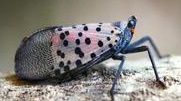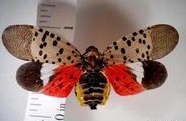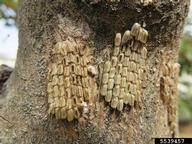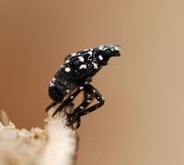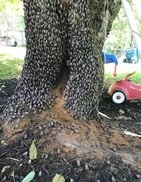Spotted Lanternfly
Lycorma delicatula
Description
The spotted lanternfly (SLF) is neither a fly nor a moth, it is a planthopper in the Order Hemiptera (true bugs, cicadas, hoppers, aphids, et.). Adults are approximately 1 inch long and ½ inch wide at rest. The forewing is gray with black spots of varying sizes and the wing tips have black blocks outlined in gray. Hind wings have contrasting patches of red and black with a white band. The legs and head are black, and the abdomen is yellow with black bands.
A single SLF adult insect was recently reported in Kansas, but SLF has not been found in Nebraska (see range information here). SLF are in their adult form from July-October annually and are most noticeable during that time frame. If you think you have seen an SLF in Nebraska, take a photo, put the insect in a zip-lock bag, freeze it, and report it here.

Early instars (immature stages; 1st, 2nd, and 3rd instar) are black with white spots. By the last immature stage, the 4th instar, they develop red patches in addition to the black color with white spots. This is the last immature stage before they mature into an adult. Adults when they have been startled expose the bright red coloration on the hind wings. When the adult is at rest, their gray, spotted color may actually cause them to blend in with their surroundings. Freshly laid egg masses appear as if coated with a white substance. As they age, the egg masses look as if they are coated with gray mud, which eventually takes on a dry/cracked appearance. Very old egg masses may look like rows of 30-50 brown seed-like structures aligned vertically in columns. Learn more and source of information Here.
Spotted Lanternfly Basics for Hops, Berry, and Vegetable Growers
February 26, 2019
Tim Weigle, Grape and Hops IPM Specialist, NYS IPM Program
Juliet Carroll, Fruit IPM Coordinator, NYS IPM Program
Ethan Angell, NYS Dept. of Agriculture and Markets
Spotted Lanternfly Basics for Grape and Apple Industries
February 26, 2019
Tim Weigle, Grape and Hops IPM Specialist, NYS IPM Program
Juliet Carroll, Fruit IPM Coordinator, NYS IPM Program
Ethan Angell, NYS Dept. of Agriculture and Markets
Spotted Lanternfly Basics for Christmas Tree Growers
March 4, 2019
Tim Weigle, Grape and Hops IPM Specialist, NYS IPM Program
Ethan Angell, NYS Dept. of Agriculture and Markets
Elizabeth Lamb, Ornamentals IPM Coordinator, NYS IPM Program
Brian Eshenaur, Ornamentals IPM Specialist, NYS IPM Program
Dan Gilrein, Entomology, Suffolk County CCE
Spotted Lanternfly Basics for Nursery, Greenhouse, and Landscape Industries
March 4, 2019
Tim Weigle, Grape and Hops IPM Specialist, NYS IPM Program
Ethan Angell, NYS Dept. of Agriculture and Markets
Elizabeth Lamb, Ornamentals IPM Coordinator, NYS IPM Program
Brian Eshenaur, Ornamentals IPM Specialist, NYS IPM Program
Dan Gilrein, Entomology, Suffolk County CCE
Source: https://www.northeastipm.org/working-groups/spotted-lanternfly/spotted-lanternfly-basics-webinars/
Host Plants
The spotted lanternfly (SLF) has been reported from over 70 species of plants, including the following. If you think you have found and SLF in Nebraska: take a photo, report it here and free the specimen.
- Tree of Heaven (Ailanthus altissima) (Preferred host and an invasive plant species)
- Maple Trees
- Apple Trees(Malus spp.)
- Stonefruit Trees including: Plum, cherry, peach, apricot (Prunus spp.)
- Hop Vines (Humulus spp.)
- Grape Vines (Vitis spp.)
- Willow (Salix spp.)
SLF can be harmful soft fruit production (listed above) by feeding on sap from stems, leaves, and trunks. The sugary secretions, excrement, created by SLF may coat the host plant, later leading to the growth of sooty mold learn more here. Sooty mold can inhibit plant photosynthesis and make outdoor furniture, such as picnic tables, unusable.
Adults are found on tree of heaven (Ailanthus altissima) which is an invasive plant. In the fall in Pennsylvania, adult spotted lanternfly prefer to feed and mate on tree of heaven when compared to other host plants. That being said, proximity to tree of heaven did not significantly influence the number of spotted lanternfly found on other hosts in a 2015-2016 host plant evaluation conducted in PA. (After spending time on tree of heaven, the insects disperse in the local area to lay eggs just about anywhere.)
Other hosts reported for this insect include: American beech (Fagus grandifolia), American linden (Tilia americana), American sycamore (Platanus occidentalis), big-toothed aspen (Populus grandidentata), black birch (Betula lenta), black cherry (Prunus serotina), black gum (Nyssa sylvatica), black walnut (Juglans nigra), dogwood (Cornus spp.), Japanese snowbell (Styrax japonicus), maple (Acer spp.), oak (Quercus spp.), paper birch (Betula papyrifera), pignut hickory (Carya glabra), sassafras (Sassafras albidum), serviceberry (Amelanchier canadensis), slippery elm (Ulmus rubra), tulip poplar (Liriodendron tulipifera) and white ash (Fraxinus americana). Learn more & source of information Here .
Pathway of Introduction and spread
SLF is considered native to parts of southeast Asia. It has been introduced as a non-native insect to South Korea and Japan. They were transported to the United States in product shipments. First detected in 2014, but appeared to have been present in the U.S. for 2-3 years (Dara et al. 2015; Barringer et al. 2015). SLF is primarily spread long distances when females lay egg masses on trains, semitrucks, various other vehicles, and products that are then moved to other locations.
Impacts & Symptoms
SLF is primarily spread long distances when females lay egg masses on trains, semitrucks, various other vehicles, and products that are then moved to other locations. NISC member Nebraska Department of Agriculture (NDA) has been conducting visual surveys since 2019 to find SLF on its preferred host, Tree-of-Heaven (Ailanthus altissima), an invasive tree species. NDA, Nebraska USDAs’ Animal and Plant Health Inspection Service Plant Protection and Quarantine Program (NE APHIS-PPQ), Nebraska Forest Service, Nebraska Extenison, NISP, and NGPC have conducted outreach to the public and resource agencies to increase early detection efforts. SLF is most visible July to October as an adult, about 1 inch long, gray with black spots, and bright red underwings see photos to right. It is recommended anyone who suspects finding a SLF in Nebraska take a photo of the insect, collect, or kill it, and report it here.
The adults and immatures damage host plants by feeding on sap from stems, leaves, and the trunks of trees. In the springtime in Pennsylvania (late April – mid May), nymphs (immatures) are found on smaller plants and vines and new growth of trees and shrubs. Third and fourth instar nymphs migrate to the tree of heaven and are observed feeding on trunks and branches. Trees may be found with sap weeping from the wounds caused by the insect’s feeding. The sugary secretions (excrement) created by this insect may coat the host plant, later leading to the growth of sooty mold. Host plants have been described as giving off a fermented odor when this insect is present. Learn more Here.
Adults may be found on the trunks of trees such as the tree of heaven or other host plants growing in close proximity to them. The USDA states that dusk is a great time to inspect your trees or other host plants for signs of this pest, as the insects tend to gather in large groups on the trunks and stems of plants at that time of day.
Tree of heaven, bricks, stone, lawn furniture, recreational vehicles, and other smooth surfaces can be inspected for egg masses. Egg masses laid on outdoor residential items such as those listed above may pose the greatest threat for spreading this insect via human aided movement. Learn more and source of informatoin Here.
Location In Nebraska
Has not been found in Nebraska. If you see an insect that looks like spotted lanternfly report it here. See distribution map here.
The Nebraska Department of Agriculture (NDA) has been conducting visual surveys since 2019 to find SLF on its preferred host, Tree-of-Heaven (Ailanthus altissima), an invasive tree species.
SLF also occurs in: Indiana, Ohio, Delaware, New York, New Jersey, Connecticut, Pennsylvania and Virginia. Access current range information here. See the potential range map of the species Here. Quarantines and eradicaiton efforts are underway to contain the insect. If you are located in an area where spotted lanternfly has been confirmed you can learn about your control options Here.
Lawrence Barringer, Pennsylvania Department of Agriculture, Bugwood.org
Pennsylvania Department of Agriculture, Bugwood.org
Kenneth R. Law, USDA APHIS PPQ, Bugwood.org
